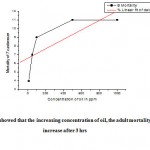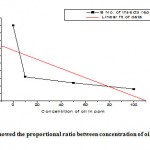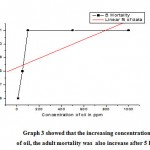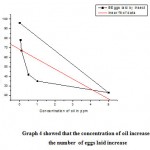How to Cite | Publication History | PlumX Article Matrix
Screening of Insecticidal Activity of Origanum Majorana Oil Against Tribolium Castenium
Naveen Sharma1, N. K. Dubey2 and Kanika Sharma1
1Microbial Research Laboratory, Department of Botany, MLS University, Udaipur, Rajasthan (India). 2Centre Advance of Science, Department of Botany, Banaras Hindu University, Varanasi (India).
ABSTRACT: Origanum majorana essential oil was tested for its potency as botanical pesticide to protect stored food commodities from insect infestation. The oil was found to be an effective repellent against the beetle Tribolium castenium (L.). An inverse relationship was observed with between concentration of oil and oviposition.Treatment of 1000 and 500 ppm found maximum mortality while 5 ppm concentration can be considered good against oviposition of insect T. castenium.
KEYWORDS: Post harvest insect; oil extract; mortality; repellency; oviposition
Download this article as:| Copy the following to cite this article: Sharma N, Dubey N. K, Sharma K. Screening of Insecticidal Activity of Origanum Majorana Oil Against Tribolium Castenium. Biosci Biotechnol Res Asia 2008;6(1) |
| Copy the following to cite this URL: Sharma N, Dubey N. K, Sharma K.Screening of Insecticidal Activity of Origanum Majorana Oil Against Tribolium Castenium. Biosci Biotechnol Res Asia 2008;6(1) . Available from: https://www.biotech-asia.org/?p=8103 |
Introduction
Severe deterioration of stored food commodities takes place due to infestation by different storage pests. Synthetic pesticides have been recommended for control of such post harvest infestations of the commodities, but due to the residual toxicities of most of the pesticides, there is need for same alternative control measures. Plants are a rich source of biologically active substances, which could be potentially harnessed to modify crop growth or protect crops against disease and pests (Mishra and Dubey, 1994; Caccioni and Guizzardi, 1994; Ghfir et.al, 1997). It has been shown that many aromatic plant species as well as their essential oils, present a high level of efficiency in protecting crops and stored food against insects pests (Arnason et.al 1989; Regnault rager and Hamroani 1993, 1995;Lamiri et.al,2001).This study investigates that the protective effect on oviposition, insect mortality and repellent activity against T. Castenium.
Materials and Methods
Extraction of volatile oil
Fresh parts of Origanum majorana plant were collected at flowering stage from the Herbal Park, Maharana Pratap University of Agriculture and Technology, Udaipur, India. Fresh parts of plant were cut and segregate into small pieces and washed with sterilized water. The essential oil was isolated through the hydro distillation by Clevenger apparatus. Two distinct layers an upper oily layer and the lower aqueous layer. Both layers were separated and the essential oils were stored in clean glass vials. (Tripathi et.al, 2004)
Test insect
Tribolium castenium (Herbst)
Rearing of test insects
Insect were collected from the Department of Entomology, Institute of Agriculture, BHU, Varanasi, India. Tribolium castenium was maintained on wheat flour at 27 ± 2 0 C and 80 ± 5 % relative humidity (Babu et. al, 2003; Jenki et. al, 2003 and Mendoza et. al, 2004) in plastic containers. Adult insects were 3 days old used for bioassay.
Study of repellent activity of oil
The essential oil was tested for its insect repellent ability against T. castenium following the methods of Dubey et. al (1989) and Varma and Dubey (1997). A Y shaped oflactometer was used for this purpose (common arm 24-cm, each branch 14.5 cm). The repellent experiment was carried out at a light intensity of 37.3 lux and 250C. Insect repellent ability of three concentrations of the essential oil i.e. 10ppm, 50 ppm and 100 ppm was assayed by keeping cotton swabs soaked in respective concentrations separately in the experimental arm. The control arm contained a cotton swab soaked in an equal amount of distilled water. Eleven adult insects of T. castenium were introduced in to the base of the stem of the Y arm of the oflactometer. After 30 minutes the numbers of insect in the experimental and control arms were counted. % repellency was calculated by the following formula Gundurao and Majumdar (1966).
% Repellency = C-E / T x 100
Where, C = Number of insects in control arm, E = Number of insects in the experimental arm and T = Total number of insects released.
Effect of essential oil on mortality and oviposition
In vivo effect O. majorana oil on T. Castenium mortality and oviposition was assayed by exposing the insects to different concentrations i.e. 10, 50, 100, 500, 1000 ppm of oil. Requisite control samples were kept for each treatment group. Observations were taken after 3 and 5 hours. All insects (live plus dead) were removed and total count of live and dead insects was made to find out mortality. Adults showing any movement of legs and antennae were considered alive. For oviposition studies, ten insect were placed with twenty five cow pea seeds mixed with respective concentrations of oil. Number of eggs laid by insects was counted with the help of a magnifier after three days. Suitable control was maintained.
Results
O.majorana oil showed a dose dependent insect repellent activity. Repellency was enhanced with increasing doses depicted in table1.84 % repellent activity was observed against T. castenium at 100 ppm. The effect of Origanum majorana oil on mortality of insects during different time interval is shown in (tables 2 & 3). 100 % mortality of insect was observed with 1000 and 500 ppm concentration of oil for t 3 and 5 hrs respectively. At 5ppm concentration of oil, the number of eggs laid decreases on cowpea seed. Similarly oviposition by T. castenium decreased with increasing the concentration of oil (table 4).
Table 1: Insect repellant activity of O. majorana oil.
| S. No. | Concentration of
oil in ppm |
No. of insects | Control Arm | Experimental Arm | % Repelency |
| 1 | 0 | 25 | 25 | 25 | 100 |
| 2 | 10 | 25 | 17 | 8 | 68 |
| 3 | 50 | 25 | 19 | 6 | 76 |
| 4 | 100 | 25 | 21 | 4 | 84 |
Table 2: Effect of O. majorana oil on adult mortality at 3 h interval.
| S.No. | Concentration
oil in ppm |
No. of insects Mortality | Mortaility | % Mortaility |
| 1 | 10 | 11 | 4 | 36.36 |
| 2 | 50 | 11 | 7 | 63.63 |
| 3 | 100 | 11 | 9 | 81.81 |
| 4 | 500 | 11 | 11 | 100 |
| 5 | 1000 | 11 | 11 | 100 |
Table 3: Effect of O. majorana oil extract on adult mortality at 5 h interval.
| S.No. S. S.No. | Concentration of oil in ppm | No. of insects Mortality | Mortaility | % Mortaility |
| 1 | 10 | 11 | 6 | 54.54 |
| 2 | 50 | 11 | 8 | 72.72 |
| 3 | 100 | 11 | 11 | 100 |
| 4 | 500 | 11 | 11 | 100 |
| 5 | 1000 | 11 | 11 | 100 |
Table 4: Effects of O. majorana extract oil on oviposition of Tribolium castenium.
| S.No. | Concentration of oil in ppm | No. of eggs laid on cow pea | No. of cow pea Seeds | No. of Insects | % eggs laid on cow pea |
| 1 | 0 | 96 | 25 | 10 | 100 |
| 2 | 5 | 23 | 25 | 10 | 23.95 |
| 3 | 1 | 35 | 25 | 10 | 36.45 |
| 4 | 0.5 | 42 | 25 | 10 | 43.75 |
| 5 | 0.1 | 67 | 25 | 10 | 69.79 |
| 6 | 0.05 | 78 | 25 | 10 | 81.25 |
 |
Graph 1: showed the proportional ratio between concentration of oil and insect repellent.
|
 |
Graph 2: showed that the increasing concentration of oil, the adult mortality was also increase after 3 hrs.
|
 |
Graph 3: showed that the increasing concentration of oil, the adult mortality was also increase after 5 hrs.
|
 |
Graph 4: showed that the concentration of oil increased, the number of eggs laid increase.
|
Discussion
majorana oil was effective in reducing T. castenium infestation in cowpea and wheat respectively. The insecticidal and repellent activity was found to be concentration of oil dependent. Reduction in oviposition suggests that the oil may have successfully inhibited the larval penetration into the seeds. Insect repellent activity of the oil indicates that it can be used as a protective agent to prevent infestation of stored grains and seeds by insect pests. T. castenium was found to be more susceptible to the oil. Differential susceptibility of insects to different botanical pesticides has been reported previously (Belmain et al., 2001). The development stage of the particular insect species may be important in determining resistance or susceptibility to chemical used as pesticides. Newly emerged beetles have been reported to be more susceptible then older beetles (Vayias et al., 2004). Semiochemicals are generally considered to be safer and more environmentally acceptable than conventional pesticides. Some other plants such as Mentha arvensis, Caesulia axillaris (Varma et al., 1997, 2007) and Securidaca longepedunculata (Jayasekara et al., 2005) have also been studied the efficacy of oil against pests of stored grains.
It can be recommended that O. majorana oil can be developed as a botanical pesticide for the management of the insect’s infestations in stored food commodities after suitable toxicity and clinical trials.
Acknowledgement
The author is thankful to the Prof. N.K.Dubey, Herbal Pesticidal Lab., Department of Botany, BHU, Varanasi for provided laboratory facilities and valuable knowledge.
References
- Arnason, J.T., B.J.R. Philogene, and P. Morand, 1989. Insecticides of plant origin. ACS Symposium Series 387, American Chemical Society, Washington, DC, 2BPP.
- Babu, A., A. Hern, and S. Dorn, 2003.Sources of semiochemicals mediating host findings in Callosobruch chinensis (Colleoptera: Bruchidae). Bull. Entomol. Res., 93,187-192.
- Belmain, S.R., G. E. Neal, D.E.Ray, and P. Golob, 2001. Insecticidal and vertebrate toxicity associated with ethanobotanicals used as postharvest protectants in Ghana. Food Chem. Toxicol., 39,287-291.
- Caccioni, D.R.L. and M. Guizzardi.1994. Inhibition of germination of fruit and postharvest pathogenic fungi by essential oil components. J. Essential oil Res., 6,173-179.
- Dubey, S., P.D. Upadhyay and S.C.Tripathi, 1989. Physicochemical and insect repellent activity of essential oil Ocimum basillicum. Can.J.Bot., 67, 2085-2087.
- Deans S.G. and K.P. Svoboda .1990.The antimicrobial properties of Origanum Majorana L. volatile oil. Flavour Fragrance J., 5,187-190.
- Ghfir, B., J.L. Fonvieille and R. Dargent, 1997. Influence of Hyssopus officinalis on the chemical composition of the walls of Aspergillus fumigatus.(Fresenius). Mycopathologia, 138, 7-12.
- Gundurao, and S.K.Majumdar, 1966. Repellency of Kaempferia galanga Linn.(Zigiberaceae) to adults of Triboliunm cataneum (Herbst). Sci.Cult.,32, 461-462.
- Jayasekara, T.K., P.C. Stevenson, D.R. Hall and S.R. Belmain, 2005. Effect of volatile constutients of Securidaca longepedunculata on insect pests of stored grain. J. Chem. Ecol., 31, 303-313.
- Jenki, D.A., F.V. Dunkel, and K.T. Gamby, 2003. Storage temperature of Neem kernel extract: differential effects on oviposition deterrency and larval toxicity of Callosobruchus maculatus (F.) (Colleoptera : Bruchidae). Environ. Entomol., 32, 1283-1289.
- Lamiri, A., S. Lhaloui, B.Benjilali, M.Berrada, 2001. Insecticidal effects of essential oils against Hessian fly, Mayetiola destructor (Say). Field Crop Research , 71, 9-15.
- Mishra A.K. and N.K. Dubey, 1994. Evaluation of some essential oils for their toxicity against fungi causing deterioration of stored food commodities. Appl. Environ. Microbiol., 60, 1401-1405.
- Perez-Mendoza, J., J.E. Throne, F.E.Dowell, and J.E.Baker.2004.Chronological age – grading of three species of stored- product beetles by using near infrared spectroscopy.J.Econ.Entomol. 97:1159-1167.
- Regnault-Roger, C. and A. Hamraoui. 1993. Efficiency of plants from the south of France used as traditional protectants of Phaseolus vulgaris L. against bruchid Acanthocelides obtectus (Say). J. Stored Prod. Res., 29,259-264.
- Regnault- Roger, C. and A. Hamraoui, 1995. Fumigant toxic activity and reproductive inhibition induced by monoterpenes on Acanthocelides obtectus (Say). J. Stored Prod. Res. 31(4), 291-299.
- Tripathi, P. and Dubey.N.K., 2004.Exploitation of natural products as an alternative stategy to control post harvest fungal rotting of fruit and vegetables. Postharvest biology and Technology, 32, 235-245.
- Varma, J. and N.K. Dubey .1987. Insecticidal and repellent activity of some essential oils against Tribolium casteneum. Natl.Acad. Sci.Lett. India, 11-12,143-147.
- Varma, J. and N.K. Dubey, 2001. Efficacy of essential oils of Caesulia axillaries and Mentha arvensis against some storage pests causing biodeterioration of food commodities. Int. J. Food Microbiology, 68: 207-210.
- Vayias, B. J. and C. G. Athanassiou, 2004. Factors affecting the insecticidal efficacy of diatomaceous earth formulation silicosec against adults and larvae of the confused flour beetle Tribolium confusum Duval (Colleoptera :Tenibrionidae). Crop Prot. 23,565-573.

This work is licensed under a Creative Commons Attribution 4.0 International License.





